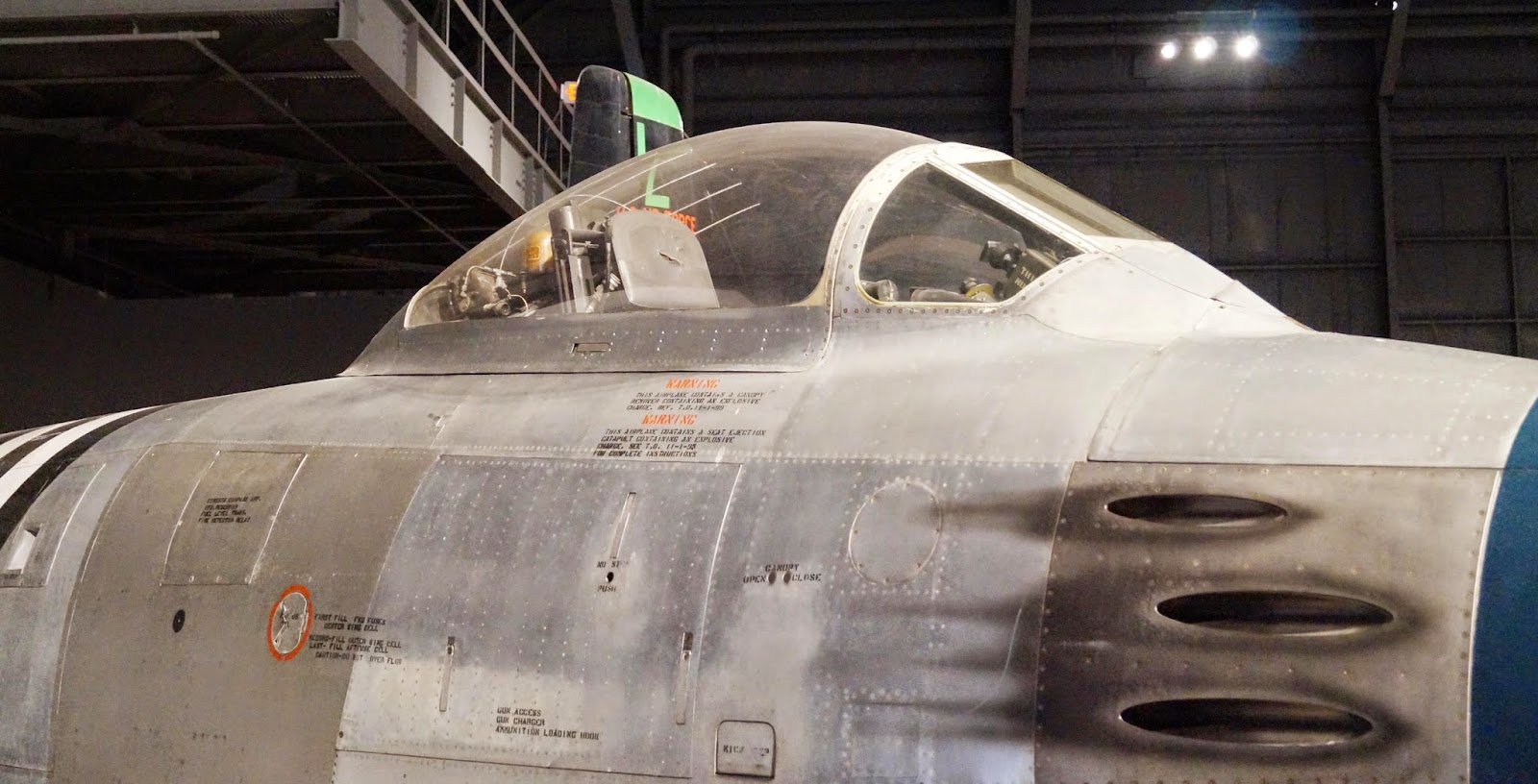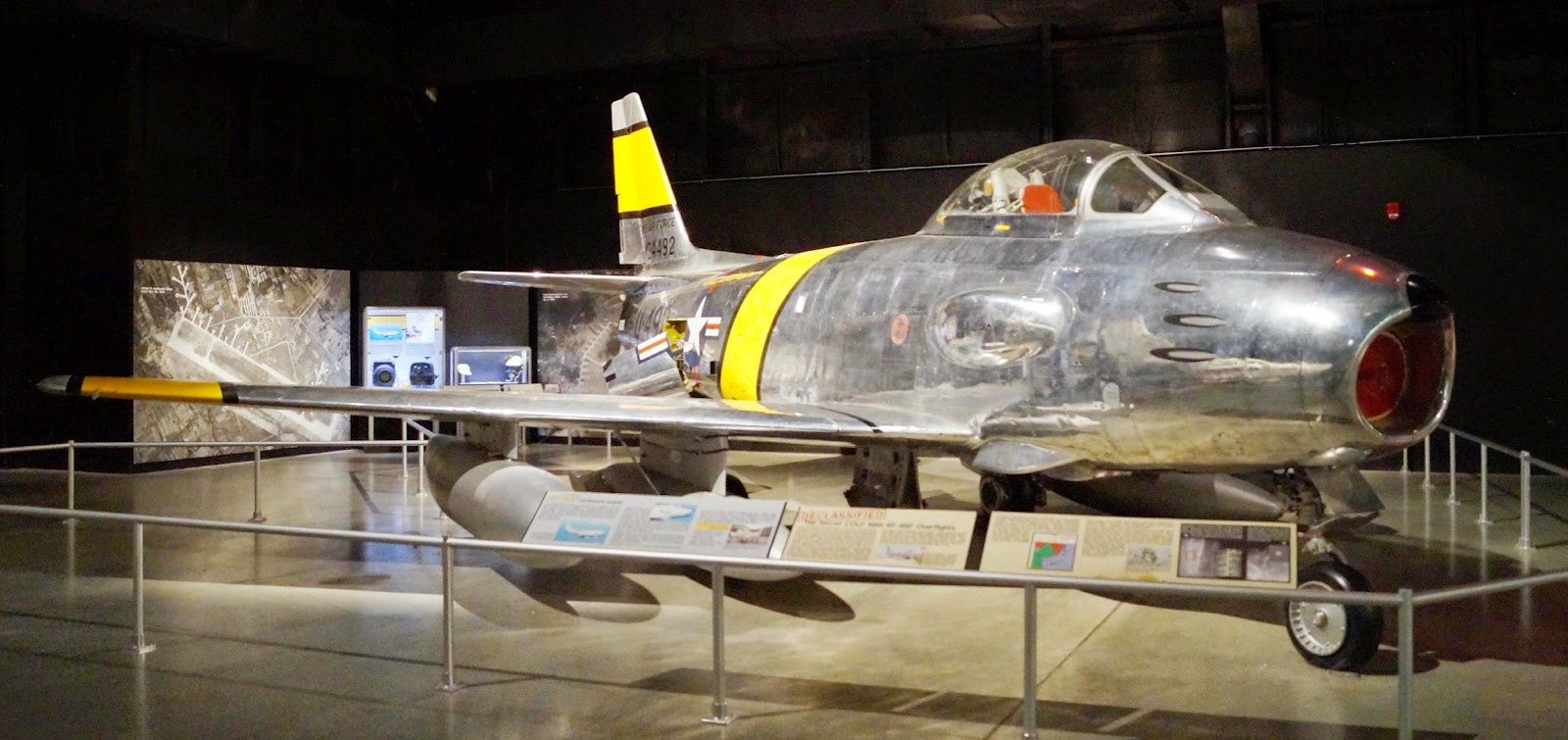Subject: North American F86A, RF86F, F86H andCanadair CL-13 Sabre
Location: F86A and F: USAF Museum, Dayton Ohio; CL13: Deutches Museum, Munich, Germany and Flugausstellung L.+P. Junior, Trier, Germany
Comments:The North American F-86 Sabre was the first American swept-wing jet plane, and was the standard fighter plane of the US Air Force in the 1950s. The F-86 was not designed as a supersonic aircraft, but nevertheless could break the sound barrier under ideal conditions. Against the backdrop of the “hot war” in southeast Asia and the political Cold War, the North American F-86 Sabre was intended to demonstrate US military strength. In reality the American design was not noticeably superior to the Soviet MiG- 15.The F-86 entered service with the United States Air Force in 1949, joining the 1st Fighter Wing's 94th Fighter Squadron and became the primary air-to-air jet fighter used by the Americans in the Korean War. While earlier straight-winged jets such as the F-80 and F-84 initially achieved air victories, when the swept wing Soviet MiG-15 was introduced in November 1950, it outperformed all UN-based aircraft. In response, three squadrons of F-86s were rushed to the Far East in December. Early variants of the F-86 could not outturn, but they could outdive the MiG-15, although the MiG-15 was superior to the early F-86 models in ceiling, acceleration, rate of climb and zoom. With the introduction of the F-86F in 1953, the two aircraft were more closely matched, with many combat-experienced pilots claiming a marginal superiority for the F-86F. MiGs flown from bases in Manchuria by Red Chinese, North Korean, and Soviet VVS pilots were pitted against two squadrons of the 4th Fighter-Interceptor Wing forward-based at K-14, Kimpo, Korea. The Canadair Sabre was a jet fighter aircraft built by Canadair under licence from North American Aviation. A variant of the North American F-86 Sabre, it was produced until 1958 and used primarily by the Royal Canadian Air Force (RCAF) until replaced with the Canadair CF-104 in 1962. Several other air forces also operated the aircraft.On 30 July 1953, the first Sabre Mk.5 flew with the Orenda 10 engine, which gave it a clear rate of climb and ceiling advantage over earlier variants. Other Mk 5 improvements included a new oxygen system and improved maneuverability and low-speed characteristics achieved by increasing the wing chord by six in (15.2 cm) at the root and three in. (7.2 cm) at the wing tip along with fitting a small vertical wing fence. This modification, originated by North American on the F-86F, dramatically improved maneuverability, though the loss of the slatted leading edge increased landing speed and degraded low speed handling considerably. Canadair built 370 Mk 5s with the majority designated for use in the RCAF’s Air Division squadrons in Europe to replace the Mk.2s. A total of 75 RCAF Sabre 5s were transferred to the German Luftwaffe during 1957. The Canadair Sabre Mk.6 was the final variant and was considered to be the "best" production Sabre ever built. It was equipped with a two-stage Orenda engine developing 7,275 lb (3,302 kg.) of static thrust. Its altitude performance and climb rate was enhanced over the Mk 5 and the reinstatement of the wing leading edge slat gave it excellent low-speed characteristics. The first production model was completed on 2 November 1954 and ultimately 655 were built with production terminating on 9 October 1958. A total of 390 Mk 6s went to the RCAF with the majority replacing the existing Canadair Sabre Mk 5s at the Air Division squadrons in West Germany and France. The main air threats to NATO in the 1950s in Central Europe were the early variants of the Soviet MiG- the MiG-15, MiG-17, MiG-19 and MiG-21. Based on the Korean War experience, the selection of the Mk 6 Sabre to provide an effective opposition to the MiG threat proved to be a logical one. Canada’s commitment to NATO was to provide 12 squadrons located at four bases – two in France (Marville and Grostenquin) and two in West Germany (Zweibrücken and Baden Soellingen). Initially, the contribution consisted of only Sabre aircraft; however, later it was decided to include the Avro Canada CF-100 aircraft in the defense package to provide a night and all-weather fighter capability.The RF-86F filled an important gap until more capable reconnaissance aircraft became available. The Sabre, originally built as a day fighter, was first modified for reconnaissance during the Korean War. USAF personnel custom-fitted cameras to about a dozen F-86 fighters (known as "Honeybuckets" or "Ashtrays") to replace the slower RF-80 for missions in northwestern North Korea -- "MiG Alley" -- and into Manchuria.The F-86H, perfected after the signing of the Korean Armistice, represented the practical application of knowledge gained from the thousands of combat missions flown by the earlier F-86A, E and F variants. Primarily a fighter-bomber, the F-86H was larger and heavier than its predecessors, but it had better all-around performance. It was armed with four M-39 20mm cannon or six .50-cal. machine guns; eight 5-in. rockets, 2,000 lbs. of bombs, or nuclear weapon
F86A:
RF86F:
CL-13:

























































